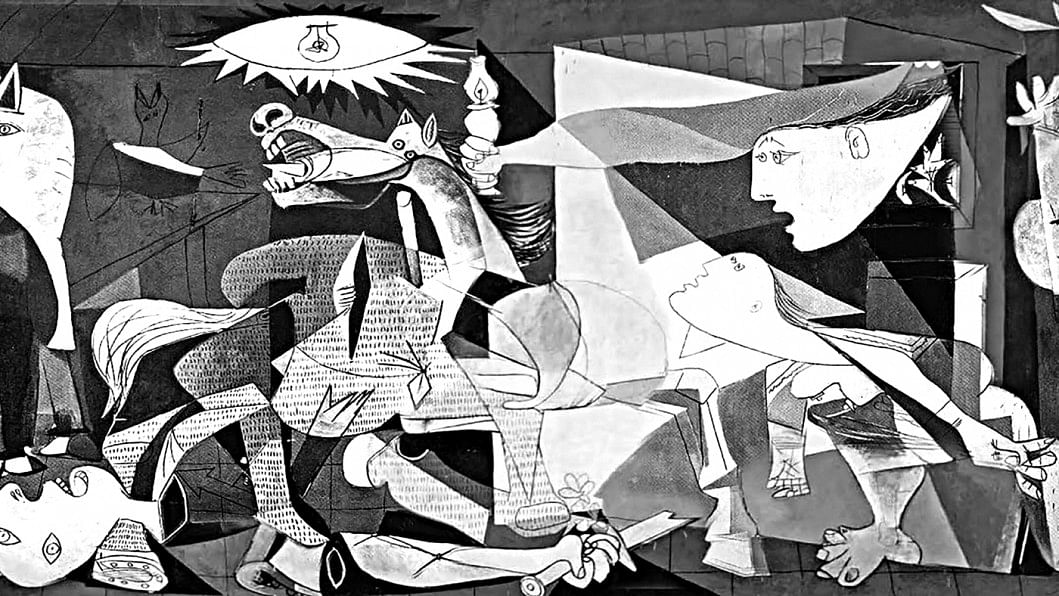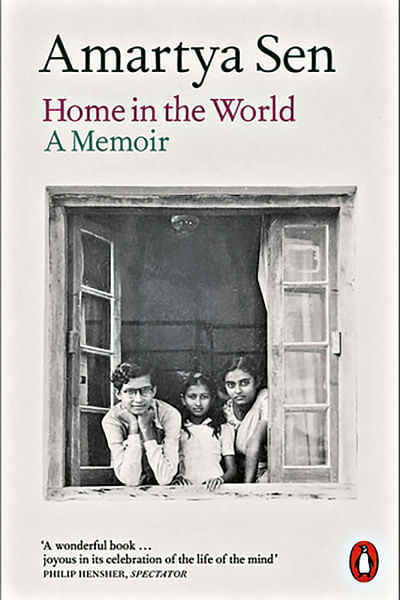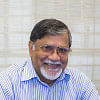Home and Displacement

The two words in the title are evocative, complex and slippery. What after all is "home", and what does "displacement" really mean?
The first word conjures up notions of romance and nostalgia, the second has more political and territorial implications. The first is based on ideas of entitlement and belongingness, the second of exile and alienation. The first suggests permanence and confidence, the second temporality and desperation.
The first is based on emotional, aesthetic and psychological parameters built around notions of identity and imagination, the second on requirements defined by bureaucratic, legal and structural contingencies.
The first connotes continuity, the second disjuncture; the first rests on feelings of comfort and security, the second on feelings of anxiety and threat; the first is shaped around a focal point, the second in a continuous state of dislocation; the first is warmly lyrical, the second coldly prosaic; the first carries a hint of metaphor and mythology, the second resonates with reality and existential urgency.

We seek to return to the first into which we are usually born, and seek to escape from the second into which we have been rudely forced.
But this litany of binaries still does not clarify what "home" means. Does this privilege "place of birth" or origin as the main signifier of home? But one can be born in an airplane, a refugee camp, or while travelling abroad?
Does it refer to acquiring one's sense of selfhood, where one grows up, and acquires one's individualism and autonomy? But the sheer mobility of people, increasingly more restless and unsettled in the modern world, problematizes even that formulation.
So, when T. S. Eliot says (in East Coker) "home is where one starts from", the "from" is left tantalizingly ambiguous. He continues: "As we grow older the world becomes stranger, The pattern more complicated, Of the dead and the living … Of old stones that cannot be deciphered".
Home, after all, is a state of mind, that we construct around our "memories and desires", dull roots sometimes "stirred by spring rain" (to continue with Eliot imagery) as we rearrange and decipher old stones and markers, partly real and evident, partly fed by myths and fantasies, of what we were, what we became, and our journey from Being to Becoming.
Perhaps Pliny the Elder, Roman naturalist and commander, was more astute when he said, "home is where the heart is", a sentiment echoed by the great philosopher Elvis Presley when he sang, "home is where the heart is baby, And anywhere you are, is home". But, the heart itself is fickle, inconstant and vulnerable to seductions. Thus, can we have more than one home?
Amartya Sen certainly thinks so. When he returned to Trinity College, Cambridge, UK in 1998, a BBC interviewer asked him, "So, where is your home?" he responded, "I feel very much at home here right now". He went on to explain that he also feels at home when he lived in Cambridge, Massachusetts, or in Santiniketan or Dhaka, where he spent his early childhood. The interviewer persists, "So, you have no concept of home", to which he replied, "On the contrary I have more than one welcoming home, but I do not share your idea that a home has to be exclusive". Incidentally, his book of memoirs is titled, "Home in the World".
The idea of multiple homes expands its ambit, but deconstructs its essentialism to the point that its very meaning becomes fluid and suspect.

Perhaps we could venture in exactly the opposite direction of "home" being where one finally rests. During the relentless westward drive of White Settlers in America, Native American leaders would resist and complain that their lands and homes were being taken away. During those days of conflict and conquest, a US colonel tauntingly asked the great Lakota leader, Chief Crazy Horse, "and so, where is your land, your home?" The Chief responded by grandly gesturing towards the horizons, and saying "wherever my braves are buried is my land, my home", thus inverting the earlier premise and suggesting that home is the place consecrated by our blood and sacrifice.
This may sound rather grim. But when the same sentiment is expressed by the great British War poet Rupert Brookes who, in his famous poem "The Soldier" memorably says "And if I should die, think only this of me, That there is some corner of a foreign field, That is forever England" it sounds more patriotic and uplifting. In both formulations the idea is that the body is the land, the signpost of home.
But if the idea of home is difficult to specify, the notion of displacement is more challenging. Is it possible to choose not to have a home, and live like wanderers, pastoralists and herders without any fixity or address? There are some 50-60 million such people today. The Bedouin, the Tuareg, the Mongols, the Romani and gypsies are the most famous, but such communities are present everywhere, even in South Asia, such as Doms, Kochs and Be-des.
In open societies, there may also be free spirits, rootless cosmopolitans and loners, rebelling against the crass culture of consumption, acquisition and display, and refusing to be trapped or numbed by the capitalist machine. What about the writers of the Beat generation (e.g., Kerouac, Ginsberg, Burroughs), or Robert Pirsig (Zen and the Art of Motorcycle Maintenance), and many others who not only dismiss, but often repudiate, the notion of having a home? Can they be considered displaced?
It is absolutely true that some artists and writers were compelled by circumstances to leave their homes and settle elsewhere such as Vladimir Nabokov, Bertolt Brecht, Albert Camus, Alexander Solzhenitsyn, Gabriel Marquez, or even perhaps Taslima Nasrin and others.
But, many more chose to live outside their original domiciles sometimes for long periods of time, sometimes their entire lives. They include mystics like Rumi, the great romantics like Keats, Shelly and Byron, and in the 20th century, T. S. Eliot, Ernest Hemingway, James Joyce, Thomas Becket, George Orwell, Oscar Wilde, Pablo Neruda, Gertrude Stein, Gabriel Marquez, Joseph Conrad, Thomas Mann, Wole Soyinka, Isabelle Allende, Joseph Brodsky and many more.

A host of writers of South Asian origin writing in English such as V. S. Naipaul, Nirad Chaudhury, Anita Desai, Salman Rushdie, Amitabh Ghose, Amit Chaudhury, Jhumpa Lahiri, Hanif Koreishi, Aravind Adiga or our very own, Tahmima Anam, Zia Haider Rahman and Monica Ali have also demonstrated that borders are porous, and can be transcended, both physically and artistically.
Painters like Picasso had to flee their land (a moment that he immortalized through his Guernica) but Monet, Pissaro, or Gauguin didn't, nor did Bangladeshi artistes like Shabuddin in France, Qazi Ghyasuddin in Japan, or Manirul Islam in Spain. Their exilic experience only fueled their creative energies. Are they displaced?
A similar definitional conundrum is faced when one considers some religious traditions and practices which are antithetical to the notion of home because of the attachments it provokes. Buddhist monks, some Catholic denominations (e. g, Franciscan orders), and several Sufi tariqas such as the Qadiriyah, Naqshbandia and Qalandaria, look upon "home" as a distraction, a trap, a deviation from the monastic purity, devotion and resolve which can only be attained through detachment from such material lusts and longings. This ambivalence resonates through Lalon Shah and the baul tradition as well.
A further complication derives from the difference between a migrant and a refugee. The first chooses to leave and re-settle elsewhere. This could be driven by hopes of a more comfortable life, more political or sexual freedoms, or a more supportive environment favorable to one's talents.
This self-conscious decision does not imply a forsaking of one's historical baggage of family bonds, cultural tastes, or individual habits. But, while the "ties that bind" remain in effect, and while the journey of re-settlement and new identities may initially entail some struggles and discomforts, and may even carry elements of anguish, guilt and after-thought, these ties eventually face "erasure" in the context of new demands, expectations and blending imperatives. At what point should they be considered displaced?
It is probably safe to say that refugees are at the very center of the displacement discourse. After all, they are compelled against their will to flee from their homes and habitats for other countries which provide an unwelcome and, usually, temporary sanctuary. Their condition is the most hauntingly and glaringly tragic.
While the reality of people travelling, moving, discovering, settling and building new homes and identities is quite old, this forced dispersal of entire groups of people across borders through war, persecution, exclusion, threat, or targeted violence, is a relatively new phenomenon.
In fact, the word "refugee", derived from the French word "refugie" and the Latin word "refugium", entered the English language only in 1685 when thousands of French Protestant Huguenots were expelled from southern and western France following the revocation of the Treaty of Nantes by Louis XIV. This had ended the fragile compromise between French Catholics and Protestants. The latter were compelled to seek shelter elsewhere.
It must be remembered that the idea of refugees was only possible AFTER the concept of the State had come into existence initially through the Treaty of Westphalia in 1648, which recognized sovereignties within national boundaries, and more fully articulated through the Congress of Vienna in 1815, which underscored legal notions of citizenship.
It was not till the 20th century that refugees became a full-fledged problem, when European Jews faced vicious anti-Semitism in many countries, and the brutal and systematic slaughter of millions in some. Many countries refused to accept them. These realities led to the Refugee Convention in 1951, which defined the term, and enunciated procedures for seeking asylum.
The UNHCR sought to bring some order, clarity and sensitivity to the whole process. By the end of 2021 this body estimated that there are more than 27m refugees, over 53m internally displaced persons, and in excess of 4.6m asylum seekers (an overall total that exceeds the population of 90% of the world's countries). These numbers are bound to increase because of the intensifying levels of hate and violence in a hyper-polarized world, and because of natural disasters and climate change disruptions that are escalating ominously.
But these figures do not capture the condition of minority communities who had felt "at home" for many years in a land which they believed was their own, to be increasingly and aggressively made aware that because of their "otherness" they cannot do so anymore.
This happens because whipping up hate is so much easier than mobilizing the acceptance of the "other". Cynical politicians have manipulated this weapon to cruel and effective advantage as they hide their prejudice, greed and hunger for power under the rhetorical froth of faith, populism, or national identity. Therefore, even though some citizens may remain legal residents of a country, they become "outsiders", strangers in their own land, who do not, and cannot, "belong", and are urged, sometimes forced, to leave (like the Rohingyas in Myanmar).
This is more painfully true for majority populations who face invisibility and dehumanization at the hands of settler colonists. In Israel/Palestine for example, one can legitimately ask, which community is it that is really displaced - those who had been compelled to leave their original homes elsewhere and sought to settle here, or those who had always been there and now suffer dispossession and disempowerment as they encounter walls and "laws" which forbid them from the very places where they had lived, and which they had "owned", for centuries?
As difficult as it may be to define or disentangle the terms "home" and "displacement", the ideas remain powerful and relevant, and are inscribed into our collective consciousness and our cultural landscape. The very centrality of the question "who am I" is inextricably bound up within a cartographic framework and the assembling of various experiential fragments into a tapestry that provides meaning, hope and agency.
In this regard art provides not only an avenue but also an inherent logic of creativity, since "displacement" constitutes a profound dislocation of texts and contexts that demand new understanding, deconstruction and engagement.
The idea is not that displacement creates great art, but that the trauma of exile, loss and longing provides new instincts, impulses, intuitions, interrogations and intimacies, a new diasporic imaginaire, new sites of contestation and coexistence, new sets of challenges and opportunities, and a new frisson of experimental and aesthetic liveliness.
The dislocated is not merely a victim and an object of history, but also an active and dynamic subject of exciting dimensions and richness. They need our support, not our pity. It is only right, indeed our moral obligation, to try to understand their struggles and sufferings, but also celebrate their spirit, their talents, and their possibilities.
The courage and foresight of the organizers at the Bangladesh Shilpakala Academy to dedicate the 19th Asian Arts Biennale to this theme deserve our gratitude, and our congratulations.
(From remarks made at the International Symposium organized under Dr. Syed Manzoorul Islam's leadership as part of the 19th Asian Arts Biennale at the Shilpakala Academy in Dhaka, Dec 8, 2022 – Jan 7, 2023.)
Dr Ahrar Ahmad is Professor Emeritus at Black Hills State University in the US, and Director General of Gyantapas Abdur Razzaq Foundation in Dhaka. He can be contacted at [email protected]

 For all latest news, follow The Daily Star's Google News channel.
For all latest news, follow The Daily Star's Google News channel. 



Comments